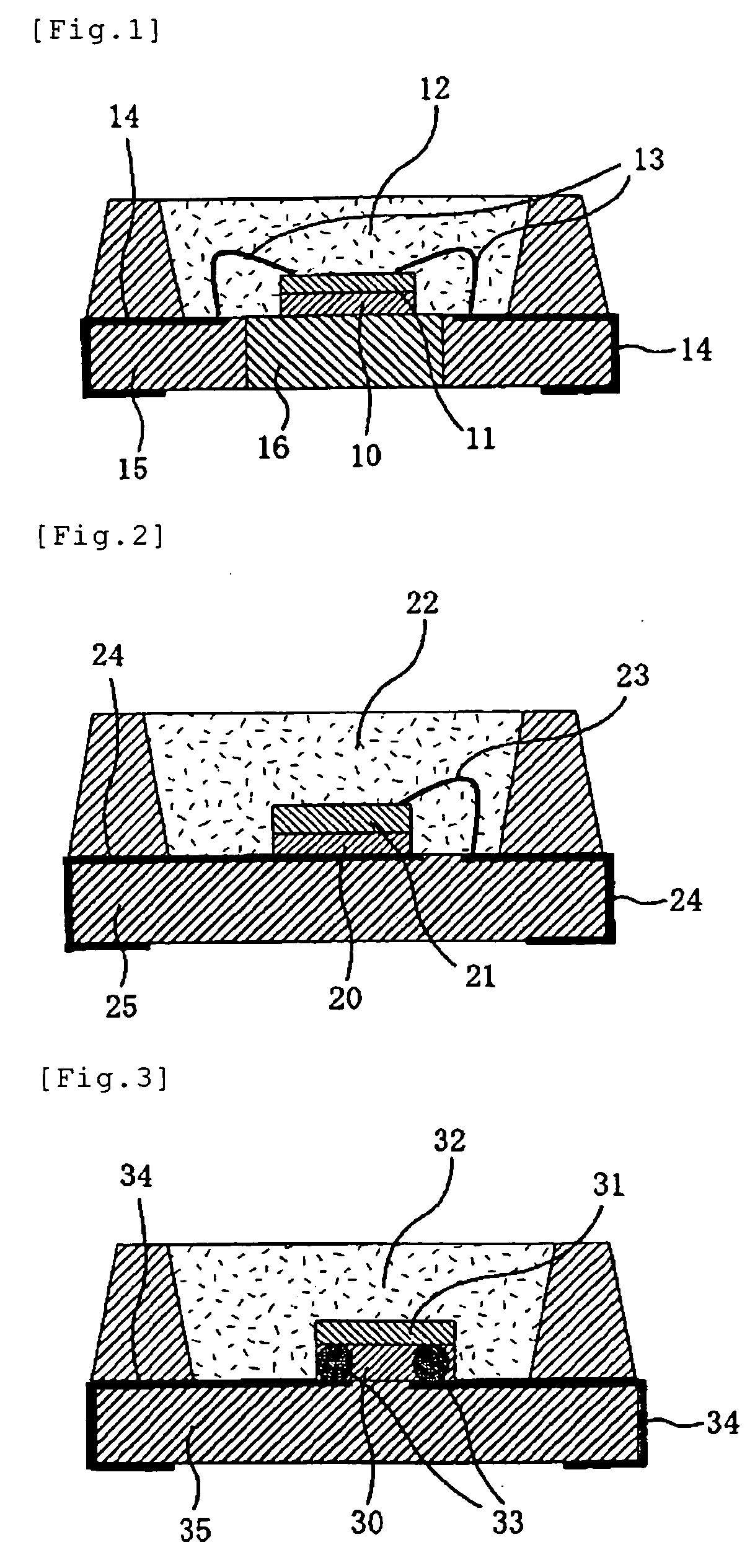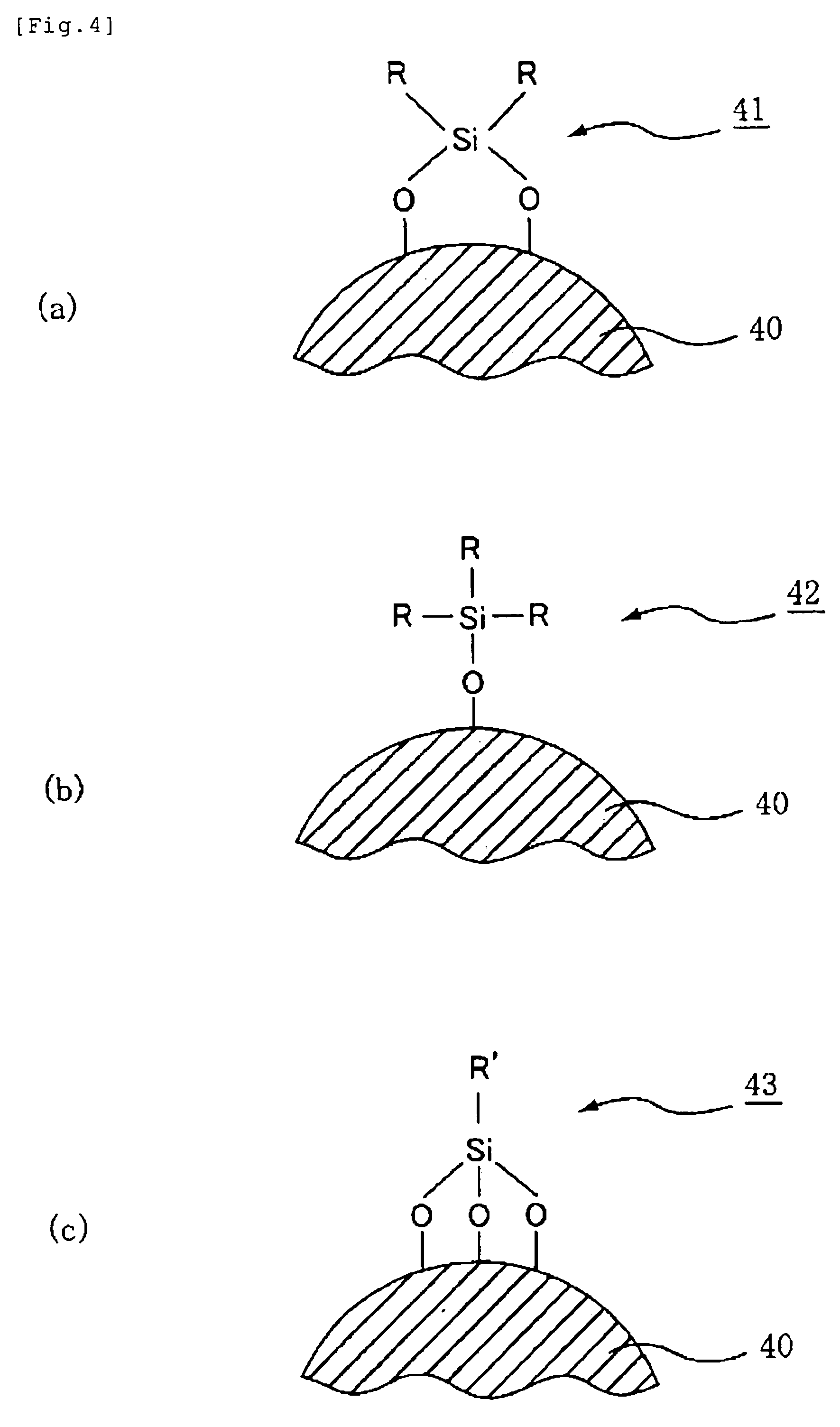Themosetting Composition for Optical Semiconductor, Die Bond Material for Optical Semiconductor Device, Underfill Material for Optical Semiconductor Device, Sealing Agent for Optical Semiconductor Device, and Optical Semiconductor Device
a technology of optical semiconductor and die bonding material, which is applied in the direction of transportation and packaging, coating, special tyres, etc., can solve the problems of hardly adequate heat resistance and lightfastness of conventional sealing agents made of epoxy resin, and the inability to respond to applications such as the headlights of automobiles or illumination lamps, so as to improve heat resistance and reduce thickness
- Summary
- Abstract
- Description
- Claims
- Application Information
AI Technical Summary
Benefits of technology
Problems solved by technology
Method used
Image
Examples
synthetic example 1
[0205]To a 2000 milliliter separable flask equipped with a thermometer and a dropping apparatus, dimethyldimethoxysilane (750 g) and 3-glycidoxypropyl(methyl)dimethoxysilane (150 g) were added, and the resulting mixture was stirred at 50° C. To this, potassium hydroxide (1.9 g) / water (250 g) were added dropwise slowly, and the resulting mixture was stirred at 50° C. for 6 hours after the completion of adding dropwise. To this, acetic acid (2.1 g) was added, and volatile components were removed under a reduced pressure and potassium acetate was filtered out to obtain a polymer. The obtained polymer was washed with hexane / water and volatile components were removed under a reduced pressure to obtain a polymer A. The polymer A had a molecular weight Mn of 11000 and a molecular weight Mw of 25000, and the formula of the polymer A was
(Me2SiO2 / 2)0.90(EpMeSiO2 / 2)0.10
from 29Si NMR analysis, and the content of a 3-glycidoxypropyl group was 14 mol % and epoxy equivalent was 760 g / eq. The cont...
synthetic example 2
[0208]To a 2000 milliliter separable flask equipped with a thermometer and a dropping apparatus, dimethyldimethoxysilane (540 g) and 2-(3,4-epoxycyclohexyl)ethyl-trimethoxysilane (60 g) were added, and the resulting mixture was stirred at 50° C. To this, potassium hydroxide (1.3 g) / water (175 g) were added dropwise slowly, and the resulting mixture was stirred at 50° C. for 6 hours after the completion of adding dropwise. To this, acetic acid (1.4 g) was added, and volatile components were removed under a reduced pressure and potassium acetate was filtered out to obtain a polymer. The obtained polymer was washed with hexane / water and volatile components were removed under a reduced pressure to obtain a polymer B. The polymer B had a molecular weight Mn of 2100 and a molecular weight Mw of 7300, and the formula of the polymer B was
(Me2SiO2 / 2)0.94(EpSiO3 / 2)0.06
from 29Si NMR analysis, and the content of a 2-(3,4-epoxycyclohexyl)ethyl group was 9 mol % and epoxy equivalent was 1270 g / e...
synthetic example 3
[0210]To a 2000 milliliter separable flask equipped with a thermometer and a dropping apparatus, dimethyldimethoxysilane (440 g) and 3-glycidoxypropyl trimethoxysilane (160 g) were added, and the resulting mixture was stirred at 50° C. To this, potassium hydroxide (1.2 g) / water (170 g) were added dropwise slowly, and the resulting mixture was stirred at 50° C. for 6 hours after the completion of adding dropwise. To this, acetic acid (1.3 g) was added, and volatile components were removed under a reduced pressure and potassium acetate was filtered out to obtain a polymer. The obtained polymer was washed with hexane / water and volatile components were removed under a reduced pressure to obtain a polymer C. The polymer C had a molecular weight Mn of 2000 and a molecular weight Mw of 3800, and the formula of the polymer C was
(Me2SiO2 / 2)0.83(EpSiO3 / 2)0.17
from 29Si NMR analysis, and the content of a 3-glycidoxypropyl group was 22 mol % and epoxy equivalent was 550 g / eq. The content of an ...
PUM
| Property | Measurement | Unit |
|---|---|---|
| mol % | aaaaa | aaaaa |
| BET specific surface area | aaaaa | aaaaa |
| average primary particle diameter | aaaaa | aaaaa |
Abstract
Description
Claims
Application Information
 Login to View More
Login to View More - R&D
- Intellectual Property
- Life Sciences
- Materials
- Tech Scout
- Unparalleled Data Quality
- Higher Quality Content
- 60% Fewer Hallucinations
Browse by: Latest US Patents, China's latest patents, Technical Efficacy Thesaurus, Application Domain, Technology Topic, Popular Technical Reports.
© 2025 PatSnap. All rights reserved.Legal|Privacy policy|Modern Slavery Act Transparency Statement|Sitemap|About US| Contact US: help@patsnap.com



